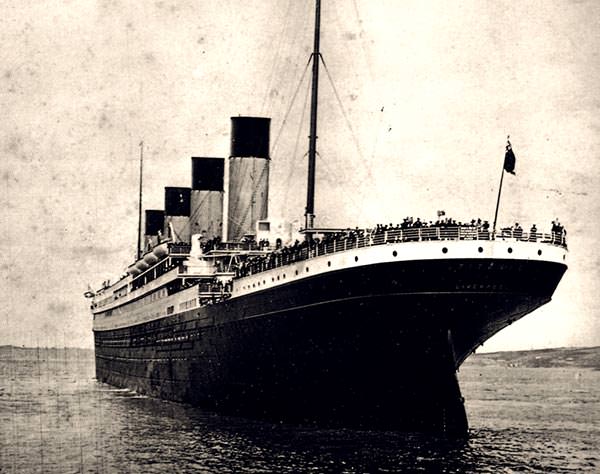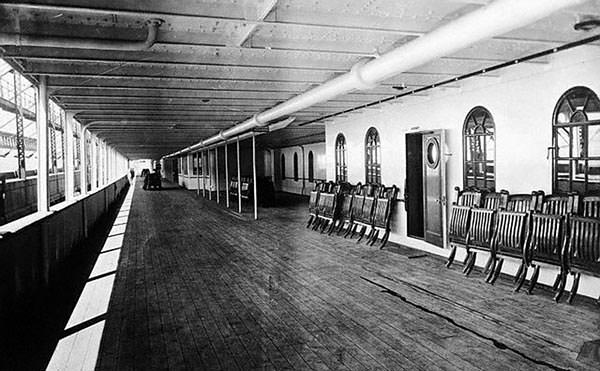Introduction
The RMS Titanic was the biggest moveable man-made object of her day, a colossal presence in the water and the subject of a tragic story that fascinates us to this day. Read on for the key facts about the ship, then explore the site further for more fascinating and moving aspects of her life and loss.
46,328 tons – the internal usable volume of the Titanic (referred to as the ‘gross register tons’ or GRT).
How long was the Titanic?
The Titanic was 882 feet 9 inches (269.1 metres) long, at the time the World’s largest man-made moving object. Today, the MS Allure of the Seas is largest passenger vessel afloat, at 1,187 feet (362 metres) long.
92 feet – her breadth (28 metres).
175 feet – the height of the Titanic, from the top of the funnels to the keel (53.3 metres).

Above: Titanic leaving Southampton at the beginning of her maiden voyage, with passengers gathered on deck.
How many rooms did the Titanic have?
There were 840 staterooms in all, 416 in First Class, 162 in Second Class, and 262 in Third Class.
900 tons – the weight of freight and passengers’ baggage carried aboard.
23 knots – the top speed of the Titanic.
Did You Know?
Titanic’s ‘home port’ (her Port of Registry) was Liverpool, however her loss at sea meant that she never did visit the city. That said, Southampton was the port she was intended to sail to and from.
29 – the number of triple-furnace coal-fired boilers powering the Titanic.
25 – the number of these boilers that were double-ended (6 furnaces each).
162 – the number of coal burning furnaces ablaze when all the boilers were operational.
6,611 tons – the amount of coal stored in the ship’s bunkers.
825 tons – the amount of coal used per day. Sister ship Olympic, comparable in size but with a lower gross register tons of 45,324, had a daily coal consumption of around 674 tons.
1,050 tons – the amount of coal used per day by the Cunard ships, which although faster were also smaller and much less fuel efficient.
100 tons – the approximate amount of ash that was dumped from Titanic into the sea each day.
How many funnels did the Titanic have?
The Titanic had four funnels, however only three of them were functional. The fourth funnel was for ventilation only, and was added for aesthetic reasons, to make the ship look more powerful and majestic. The funnels extended high above the deck, in order to ensure that passengers were not covered in the soot being ejected.
150 feet – the height that the funnels extended above the boilers.
81.5 feet – the height that the funnels extended above the deck.
60 tons – the weight of each funnel.
1:6 – the angle at which the funnels were raked back, in order to make their visual appearance even more impressive.
How many decks did the Titanic have?
There were 10 decks in total. From top to bottom they were the Boat Deck, the Promenade Deck (deck A), passenger decks B to G, Orlop Deck, and the Tank Top.
You could actually walk miles along the decks and passages covering different ground all the time. I was thoroughly familiar with pretty well every type of ship afloat but it took me 14 days before I could, with confidence, find my way from one part of that ship to another. -Charles Lightoller, Titanic Second Officer

Above: A photograph of the Promenade (A) Deck of the Titanic. The open door shown on the right led onto the Grand Staircase.
10,000 – the approximate number of light bulbs on the ship.
3 – the number of engines used to power the ship, 2 outboard reciprocal engines (which could move the ship forward or backwards) and a central steam turbine engine, which ran forward only.
4 – the number of decks tall at which the two main engines stood, being the largest ever built at the time.
3 – the number of propellers, 2 outboard (3 x 10′ blades) driven by the main reciprocal engines, and a central prop (4 x 6′ blades) powered by the steam turbine engine.
38 tons – the weight of the two outer propellers, which were made of bronze.
22 tons – the weight of the central propeller, of a moulded construction.
Did You Know?
The Titanic was initially known as the SS Titanic (‘SS’ meaning Screw Steamer, i.e. driven by propellers or screws, also standing for ‘Steamship’), only becoming officially recognised as the RMS Titanic after first carrying the Royal Mail. ‘RMS’ refers to Royal Mail Ship or Royal Mail Steamer.
2 – the number of anchors.
15 tons – the weight of each anchor.
15 – the number of transverse water-tight bulkheads.
69 feet – the length of the room in which the reciprocating engines were located.
57 feet – the length of the turbine room.
So thorough are the precautions which have been taken to prevent the ship from sinking in the event of a serious accident that any two compartments may be flooded without endangering the safety of the vessel. -From the Belfast Newsletter report on the launch of Titanic, published Thursday 01 June 1911.
131,428 – the official number of the ship.
1,200 miles – the typical range of the Titanic’s wireless equipment at night.
400 miles – the typical range of the same wireless equipment during daylight hours (due to heavier use of the airwaves by other shipping).
1955 – the year in which Walter Lord (1917 – 2002) published A Night To Remember, his popular non-fiction account of the Titanic tragedy, released as a movie in 1958 and credited with regenerating public interest in the story, which had wained over the years.
In the creation of the Titanic myth there were two defining moments: 1912, of course, and 1955. -Steven Biel, cultural historian, on the influence of A Night To Remember
More To Explore
Read about the construction of the Titanic and more facts about the Titanic’s size.
